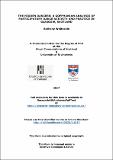Files in this item
The hidden dancers : a Goffmanian analysis of participatory dance activity and practice in Glasgow, Scotland
Item metadata
| dc.contributor.advisor | Broad, Stephen | |
| dc.contributor.advisor | Kelly, John | |
| dc.contributor.author | Whiteside, Bethany | |
| dc.coverage.spatial | 332 p. | en_US |
| dc.date.accessioned | 2017-06-19T10:25:21Z | |
| dc.date.available | 2017-06-19T10:25:21Z | |
| dc.date.issued | 2017-06-22 | |
| dc.identifier.uri | https://hdl.handle.net/10023/11017 | |
| dc.description.abstract | Sociology of dance is an evolving discipline that takes as a central focus the social makeup of dance – the societal structures and individual agency that are inherent within dance activity and practice. Relevant ethnographic literature that adopts particular sociological concepts and models is generally narrow in focus, with attention centred on the frameworks of Pierre Bourdieu and Michel Foucault and the conformation of vocational and professional ballet and contemporary dancer minds and bodies, to particular practice-specific behaviours and beliefs. Through drawing on Erving Goffman’s (1959/1990) model of dramaturgy, this interdisciplinary thesis uncovers and interrogates the two-way relationship between sociological micro relations (social interactions), and various types of dance activity and practice. Six case studies undertaken encompass a wide range of dance and social settings; the professional ballet class, inclusive creative dance class, line dancing class, salsa club, Highland dancing class, and dance in primary education. Data was collected through undertaking participant observation (primary method) and qualitative interviews (secondary method): each specific combination was influenced by the reflexive approach followed, the nature and setting of each case study and as researcher, my own dance ability. The transcripts and field notes were analysed and situated within Goffman’s (1959/1990) framework to interrogate the social and dance ‘performances’ given. The research aims to firstly, uncover and present the nature of the ‘realities’ (Goffman, 1959/1990) within each setting and secondly, to interrogate and demonstrate the applicability of the dramaturgical model to dance scholarship. The findings reflect the sociological binary of individual agency and societal structures as realities were shaped by the ‘place’ of each dance activity and practice in the field of dance, and challenged, maintained or supported existing dominant perceptions. | en_US |
| dc.description.sponsorship | ESRC CASE Studentship with industry sponsor Creative Scotland, ‘Capacity Building Cluster’ grant # RES 187-24-0014 | en |
| dc.language.iso | en | en_US |
| dc.rights | Attribution-NonCommercial-NoDerivatives 4.0 International | * |
| dc.rights.uri | http://creativecommons.org/licenses/by-nc-nd/4.0/ | * |
| dc.subject | Sociology of dance | en_US |
| dc.subject | Ethnographic research methods | en_US |
| dc.subject | Erving Goffman | en_US |
| dc.subject | Participatory dance | en_US |
| dc.subject.lcc | GV1588.6W55 | |
| dc.subject.lcsh | Dance--Sociological aspects | en |
| dc.subject.lcsh | Dance--Scotland--Glasgow | en |
| dc.subject.lcsh | Goffman, Erving | en |
| dc.title | The hidden dancers : a Goffmanian analysis of participatory dance activity and practice in Glasgow, Scotland | en_US |
| dc.type | Thesis | en_US |
| dc.contributor.sponsor | Economic and Social Research Council (ESRC) | en_US |
| dc.type.qualificationlevel | Doctoral | en_US |
| dc.type.qualificationname | PhD Doctor of Philosophy | en_US |
| dc.publisher.institution | The University of St Andrews | en_US |
| dc.publisher.department | Royal Conservatoire of Scotland | en_US |
The following licence files are associated with this item:
This item appears in the following Collection(s)
Except where otherwise noted within the work, this item's licence for re-use is described as Attribution-NonCommercial-NoDerivatives 4.0 International
Items in the St Andrews Research Repository are protected by copyright, with all rights reserved, unless otherwise indicated.


